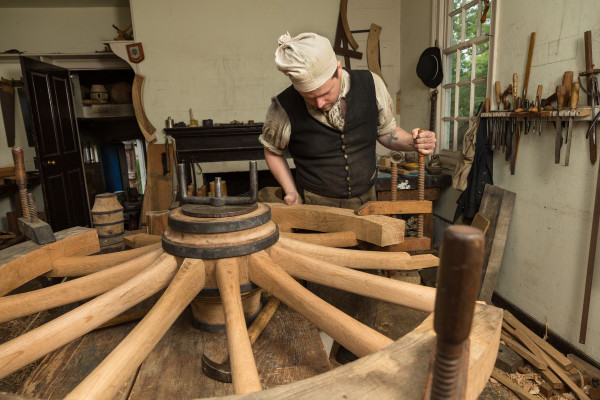
By Ben Swenson
Entrepreneurs love to see business coming through the door. But when your line of work is an 18th-century Historic Trade, walk-ins are a rarity.
Yet that’s what happened last year at the Colonial Williamsburg Wheelwright and Carriage Shop. Matthew Mees and his wife were visiting the Revolutionary City and made a point to drop in on the wheelwrights. After all, Mees was in the market for a sturdy pair of 18th-century gun-carriage wheels.
[brightcove videoID=4305450618001 playerID=3703125019001 height=315 width=560]
Mees is the president of the Braintree Historical Society in Massachusetts. The Historical Society is the steward of historic resources in the Boston suburb and among the Historical Society’s collections is an antique French cannon that has outlasted at least two carriages.
Though a carriage had been built for the barrel in the 1980s, the wheels rotted beyond repair over the years, and the now-wheel-less piece of artillery needed a new pair. But these would be no standard order, because Mees insisted that they mirror the wheels this cannon probably sported during its years of original service.
The Braintree Historical Society received the 1793 cannon barrel as a gift some 50 years ago. The cannon has been parked for decades at the Braintree birthplace of General Sylvanus Thayer, known as “the Father of West Point,” the United States Military Academy. When donors provided funds to secure a replacement pair of wheels, Mees weighed all his options before committing.
Prior to reaching out to Colonial Williamsburg, “I had been sending requests for proposals to various wheelwrights,” Mees said. “They’d say, ‘Oh yeah, I’ll rebuild those wheels,’ but then they saw the task, and they would back off.”
Reproducing artifacts can be challenging because every culture expresses itself in different ways. There are curves in French spokes, for example, where English-styled spokes are straight, slants in French-made joints where others remain flat—differences you might not see unless you were looking for them, but differences Mees required for accuracy’s sake.

“It’s a very specific artillery design,” Mees said. “Colonial Williamsburg’s wheelwrights had done French artillery before, but never anything this large and they seemed excited to have this opportunity.”
The wheelwrights gladly accepted the challenge, said Andrew De Lisle, journeyman wheelwright and front man for this project. Part of their willingness was simply tradition; Colonial Williamsburg’s tradesmen have a long history of making items used far and wide for historical interpretation, a practice that began in the 1930s when the museum’s first employees reproduced furniture used in the Historic Area and at Colonial National Historical Park.
Among the museums that own products made by the wheelwrights (not to mention many other Colonial Williamsburg Historic Trades) are the Smithsonian Institution’s National Museum of American History, Fort Ticonderoga and Genesee Country Village and Museum.
These tradesmen carry another mantle, as well—that of the art of wheelwrighting. The apprentice fraternity for the trade is small, De Lisle said, and that means there are few accessible reference works to guide them through unfamiliar processes. Their work is always a learning process, especially when it comes to employing techniques they don’t often use.
Take the curved spokes, for instance. De Lisle said there’s no obvious explanation for why French wheelwrights opted for that design over the seemingly more practical, English-style straight spokes. “We have more than 50 years combined experience in the wheelwright shop and none of us are completely sure.”
Colonial Williamsburg’s blacksmiths collaborated with the wheelwrights on this project, creating the wheel’s strakes, or metal rims, and other hardware. Even in those iron reinforcements, the tradesmen had to re-create subtle differences in style, clustering nails, for instance, where English blacksmiths fashioned them in a line.
And that immersion in new techniques not only adds to tradesmen’s experiences, it also offers insight into the reason behind specific designs. De Lisle said that the curved spokes might have been a little faster to make. Or perhaps it’s just that the design looked nice and caught on among wheelwrights. De Lisle said that he and his colleagues still aren’t sure, but making the wheels allowed them to offer a couple good guesses.
“Often gauges and techniques don’t make sense to us until we make something,” De Lisle said. “It’s quite a learning experience leaping from one culture to another.”
The education isn’t confined strictly to the tradesmen at Colonial Williamsburg; When the finished wheels are attached to the carriage in Braintree, Mees plans to use the artillery to transport people back to the 18th century.
“Everything about this piece is a teaching moment. Every cannon has a name, it has a seal including who the ruler is at the time, sometimes it has a motto. The barrel says when the tube was made, who made it and where. And the carriages, of course, are a very particular type of this era.
“When you look at this cannon, it’s going to take you back to 1793,” Mees said.

Leave a Reply